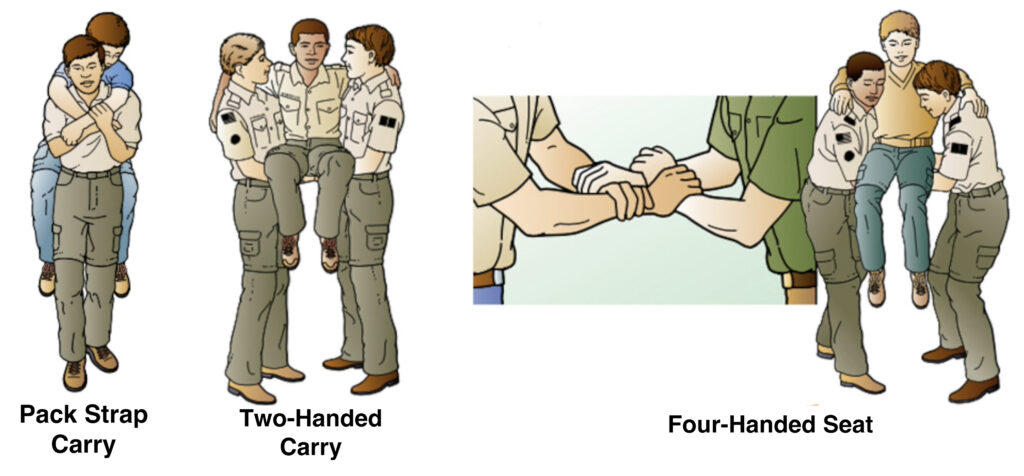SCOUTS HAVE FUN PUTTING THEIR SKILLS INTO ACTION WITH THE FIRST AID CARRY RELAY
The decision to move an accident victim should be made carefully. In many cases, emergency medical crews or fire department personnel will be able to transport an injured person. However, if someone is exposed to fire, smoke, water, electrical hazards, poisonous gases, dangerous weather conditions, or other immediate threats, the right decision could be to move that person to safety. Here are three first aid carries that you should know:
Pack Strap Carry – This method is a way for a single first aider to transport someone no larger than himself. Use this method for emergency moves or after determining that the victim can be carried without making their injuries worse, Squat down and pull the person onto your back with their arms around your neck. Hold the arms firmly and stand up.
Two-Handed Carry – Use this method if the victim is conscious and not seriously injured. With one other rescuer, place your arms on each other’s shoulders. Then link your free arms by grabbing each other’s wrists. Ask the injured person to sit on your linked arms. With the person sitting there comfortably, move your arms down from each other’s shoulders to support the victim’s back.
Four-Handed Seat – When no rescue equipment is available, the four-handed seat is the easiest two-rescuer carry. It is safe only if the victim is conscious and can hold on. Face the other first aider and lock arms. Have the victim sit on your hands and put their arms around your shoulders.

After you learn these first aid carries, put them into action in a fun way that gives you practice. Here’s a friendly competition your troop will really enjoy:

Patrols line up in relay fashion facing a single turnaround post located 15 feet away. One Scout carries the first “injured Scout” using a Pack Strap Carry around a turnaround pint and back to the starting line. Next, Two Scouts from each patrol carry the second “injured Scout” using a Two-Person Carry around the turnaround point and back to the starting line. Finally, two Scouts carry the third “injured Scout” using a Four-Handed Seat Carry around the turnaround point and back to the starting line. If at any time an “injured Scout” touches the ground, the Scouts carrying this “injured Scout” must stop, reform their carry and continue.

The first patrol making a complete circuit with the three “injured Scouts” wins.
Refer to the Scouts BSA Handbook for more information about moving an ill or injured person. For a library of ideas on how to make more fun happen during meetings and outings, visit the activities section of the Troop Leader Resource Hub: https://troopleader.scouting.org/activities/
View the video: https://youtu.be/_HhfHgspcO4?si=AwF-T0zL4WC5Rweu